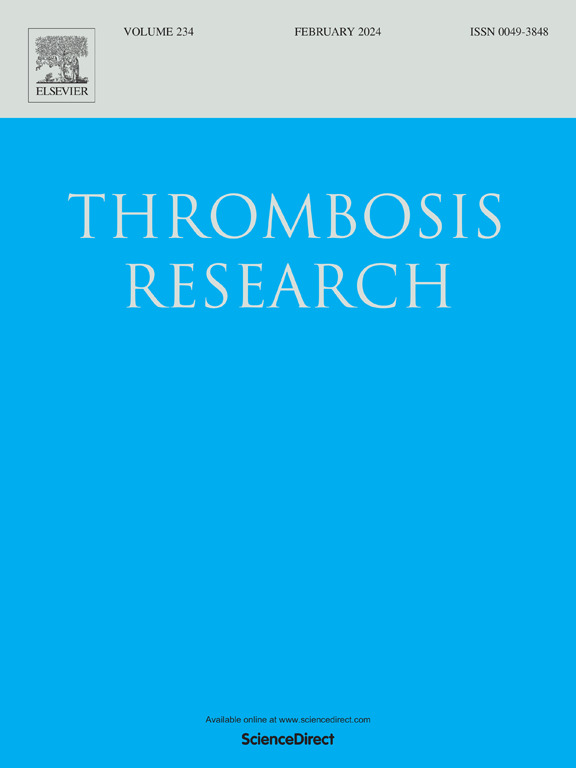Activation of the pentose phosphate pathway mitigates platelet storage lesions and improves platelet preservation quality
IF 3.4
3区 医学
Q1 HEMATOLOGY
引用次数: 0
Abstract
Background
Platelet storage lesions (PSLs) impact platelet lifespan and transfusion quality. This study explores platelet storage metabolism for potential interventions.
Methods
Samples were collected on days 1, 3, and 5 for untargeted metabolomics analysis to identify metabolites that differ with storage time and potential metabolic pathways. The activities of glucose-6-phosphate dehydrogenase (G6PD) and cyclooxygenase-1 (COX-1) in platelets during storage were measured. Meanwhile, flow cytometry was used to assess changes in apoptosis and mitochondrial function of stored platelets treated with either a G6PD inhibitor, a G6PD activator, or a COX-1 inhibitor. Platelet aggregation was used to evaluate platelet function. Megakaryocyte/platelet-specific G6pd knockout mice were used to assess the role of G6PD in PSLs.
Results
The pentose phosphate pathway (PPP), arachidonic acid metabolism, and linoleic acid metabolism were enriched during storage. A total of 4832 platelet metabolites and 6468 plasma metabolites were identified, with 44 and 108 showing nominally significant changes respectively. An increase in G6PD activity was observed at the early stages. Inhibiting G6PD with G6PDi-1 damages mitochondria, increases phosphatidylserine externalization, and impairs platelet aggregation. Mouse G6pd−/− platelets exhibited increased PSLs. Activation of G6PD with AG1 reduces mitochondrial reactive oxygen species (mtROS) and phosphatidylserine externalization while enhancing platelet aggregation. Additionally, although COX-1 activity in the arachidonic acid metabolism pathway increases at the early stage, its inhibition by the COX-1 inhibitor aspirin does not significantly alter PSL-related indicators.
Conclusion
The pentose phosphate pathway maintains platelet mitochondrial function via G6PD regulation, making G6PD a critical target for reducing PSLs.
磷酸戊糖通路的激活可减轻血小板储存损伤,提高血小板保存质量
血小板储存病变(PSLs)影响血小板寿命和输血质量。本研究探讨血小板储存代谢的潜在干预措施。方法在第1、3、5天采集样品进行非靶向代谢组学分析,鉴定不同储存时间和潜在代谢途径的代谢物。测定血小板贮藏过程中葡萄糖-6-磷酸脱氢酶(G6PD)和环氧化酶-1 (COX-1)的活性。同时,流式细胞术用于评估储存的血小板在G6PD抑制剂、G6PD激活剂或COX-1抑制剂处理后细胞凋亡和线粒体功能的变化。采用血小板聚集评价血小板功能。使用巨核细胞/血小板特异性G6pd敲除小鼠来评估G6pd在psl中的作用。结果贮藏期间戊糖磷酸途径(PPP)、花生四烯酸代谢和亚油酸代谢增加。共鉴定血小板代谢物4832种,血浆代谢物6468种,其中名义上有显著变化的有44种,名义上有显著变化的有108种。早期观察到G6PD活性增加。用G6PDi-1抑制G6PD损伤线粒体,增加磷脂酰丝氨酸外化,并损害血小板聚集。小鼠G6pd−/−血小板显示psl升高。用AG1激活G6PD可减少线粒体活性氧(mtROS)和磷脂酰丝氨酸外化,同时增强血小板聚集。此外,虽然花生四烯酸代谢途径中的COX-1活性在早期升高,但COX-1抑制剂阿司匹林对其的抑制作用并未显著改变psl相关指标。结论戊糖磷酸途径通过调控G6PD维持血小板线粒体功能,使G6PD成为降低PSLs的关键靶点。
本文章由计算机程序翻译,如有差异,请以英文原文为准。
求助全文
约1分钟内获得全文
求助全文
来源期刊

Thrombosis research
医学-外周血管病
CiteScore
14.60
自引率
4.00%
发文量
364
审稿时长
31 days
期刊介绍:
Thrombosis Research is an international journal dedicated to the swift dissemination of new information on thrombosis, hemostasis, and vascular biology, aimed at advancing both science and clinical care. The journal publishes peer-reviewed original research, reviews, editorials, opinions, and critiques, covering both basic and clinical studies. Priority is given to research that promises novel approaches in the diagnosis, therapy, prognosis, and prevention of thrombotic and hemorrhagic diseases.
 求助内容:
求助内容: 应助结果提醒方式:
应助结果提醒方式:


